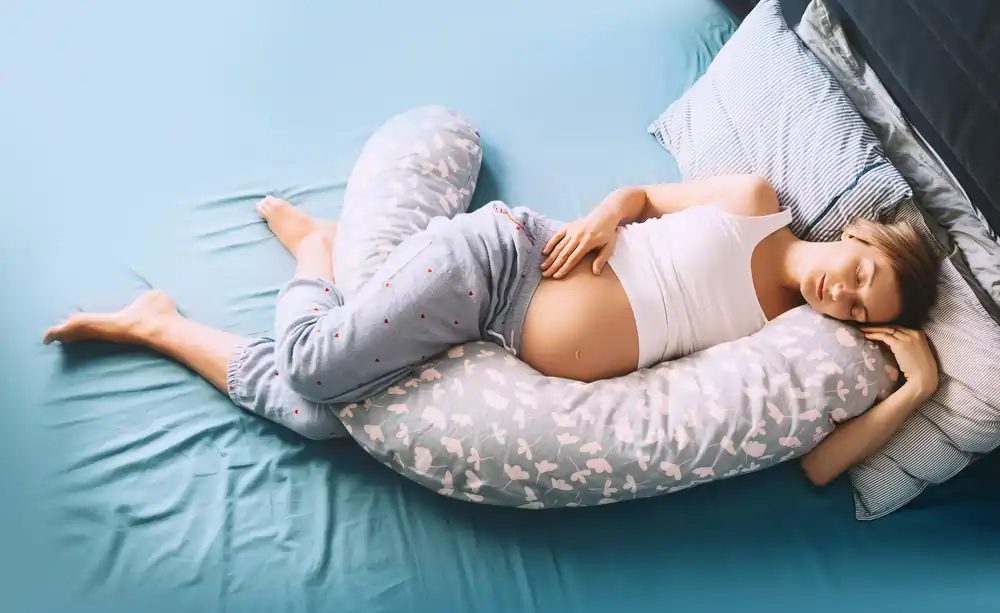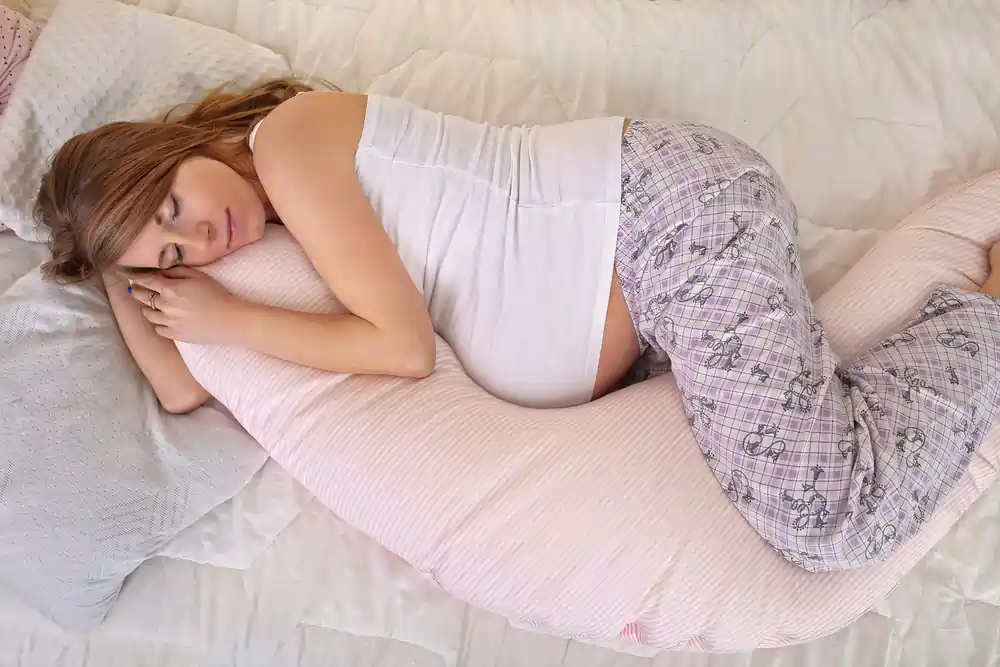Pregnancy Sleeping: Best Sleeping Position During Pregnancy
Share
Fact checked
Reviewed by experts
Updated
December 6, 2022
Quick read
7 mins to read
List of Content
Safe Sleeping Positions While Pregnant
You’ve prepared yourself for morning sickness, you’re ready for swollen ankles, you’ve even prepared yourself for mood swings that may strike at any moment because of the river of hormones that have begun to flood your body, but what you may not have realized is how much pregnancy may affect your sleep. Sleeping is how we spend an entire third of our time on this planet, and that’s because it serves a role as vital to our health as eating or drinking water.
When pregnancy begins to disrupt our sleep it is vastly important for the health of both you and your baby to learn what steps you can take to become a master at sleeping while pregnant. Part of sleeping soundly is having peace-of-mind that your sleep position won’t harm you or your new babe. There are a few positions that you can count on for a good night of rest while you’re pregnant:
Your back…
…but only in the very early stages of pregnancy. Once your baby starts growing and you start to have more around your middle, the pressure of this weight may lead to serious complications.
Your stomach…
…but again, only in the early stages of pregnancy. Sleeping on your stomach is not recommended even for those who are not pregnant because it tends to cause undue stress on your neck and upper back. If this is the only position you feel comfortable enough to actually get some rest in, then by all means sleep on your stomach.
Know that later in your pregnancy when your baby is getting bigger, sleeping on your stomach will most likely become extremely uncomfortable for you as well as dangerous for your baby.
Your side
Sleeping on your side is widely regarded as one of the best positions you can sleep in while pregnant and is probably the safest choice. When you sleep on your side you relieve unnecessary pressure from your internal organs or the baby that may otherwise cause complications.
If you start training yourself to sleep on your side in early stages of pregnancy you will have a much easier time transitioning during the later stages of your second and third trimester, when sleeping on your side becomes more necessary.
Reasons of discomfort in Pregnancy
If you are currently pregnant or have gone through pregnancy before, we don’t have to tell you that it can leave you feeling extremely uncomfortable. Your body undergoes some pretty incredible changes over the 9 months that you are carrying your little sweetheart, but as beautiful as these changes are they can, at times, feel like a burden on your health and well-being. Some of the most common reasons for discomfort in pregnancy are listed below.
Increased size of abdomen
Steadily increasing in size may cause an array of stressors to your body that you may never have experienced before. You may find stretch marks, start snoring, and find that your ankles are swollen. Welcome to the world of pregnancy, my friends.
Back pain
This one is part and parcel with a growing belly. As the size of your mid section grows, you attempt to compensate by shifting your posture backwards in order to maintain your sense of balance. This puts more stress on your back and may create back pain, especially later in stages of pregnancy.
Heartburn
Hormonal and physical changes may be the cause for heartburn in pregnant women and when you are towards the end of pregnancy, your growing baby may crowd your abdominal cavity that may push stomach acid up towards the esophagus. Sounds fun, right?
Shortness of breath
If you are experiencing shortness of breath while pregnant, you may want to try using pillows to prop yourself up in a half sitting position while you sleep. This encourages better airflow in your body and may help you to get those long, deep, slow breaths that your body needs to relax and drift off.
Insomnia
Insomnia while pregnant is one of the most common symptoms because of the immense changes that your body is going through. Generally, insomnia is not an isolated symptom, but shows itself alongside numerous other symptoms that may be contributing to your sleeplessness.
The frequent urge to pee
Along with all of the other places that your growing baby is putting pressure on in your body, the pressure put on your bladder is probably one of the most notable, because you will feel like you need to pee almost all of the time. This may also be a large factor in why you are experiencing insomnia.
leg cramps and backaches
Cramps and aches of all sorts are common during pregnancy, and the causes are dependent on a person by person basis. Taking time to get in some exercise, stretching, and staying hydrated are all ways to mitigate these symptoms.
Increased heart rate
Merckmanuals.com explains that “during pregnancy, the amount of blood pumped by the heart (cardiac output) increases by 30 to 50%. As cardiac output increases, the heart rate at rest speeds up from a normal prepregnancy rate of about 70 beats per minute to 80 or 90 beats per minute.”
What Are The Best Sleep Positions During Pregnancy?
If you’re pregnant you’ve undoubtedly dealt with some of the uncomfortable symptoms listed above. The good news is that finding a comfortable position to sleep in that leaves you well-rested in the morning may help to reduce the negative symptoms you experience.
Sleeping on your side, especially in the later stages of pregnancy, has been shown to reduce instances of stillbirth. According to tommys.org, a site of evidence-based, expert-led, accessible pregnancy information, sleeping on your side has been associated with healthier and less risky births. Keeping your knees bent in what it sometimes referred to (ironically enough!) as the fetal position is viewed as one of the most comfortable positions to sleep in during pregnancy.
If you are experiencing acid reflux or heartburn, sleeping in an upright position may help to reduce these frustrating symptoms. Fluff up some pillows behind your back, similar to what you would do if you had a cold and didn’t want drainage leaking down the back of your throat, and sleep propped up, to help discourage any stomach acid that wants to sneak it’s way up your esophagus.
Sleeping positions to avoid during pregnancy:
Sleeping on your back during pregnancy is one of the worst positions you can sleep in, especially as your baby grows. If you sleep on your back and you are in your later trimesters, it can cause muscle aches and pains, hemorrhoids, swelling, drop in blood pressure, which can make you dizzy. In some cases, women can experience an increase in blood pressure instead of a decrease. Snoring is also a possibility and may lead to sleep apnea as your weight increases. Babycenter.com explains that if you’re ”sleeping on your back in the later trimesters, the weight of your uterus will press on your spine, back muscles, and major blood vessels, which can decrease blood flow around your body and to your baby.”
Stomach sleeping is also ill-advised when you are pregnant. Not only is it difficult to manage with a protruding baby bump, but the pressure that sleeping on your stomach puts on your baby while you are pregnant can be harmful to you both.
How to sleep comfortably on your side during pregnancy
Pillows, pillows, and more pillows! Sleeping on your side during pregnancy while staying comfortable is all about the pillows. When you are sleeping on your side try placing a pillow under your baby bump. This will help to relieve pressure from the weight of your belly off of your back and hips. Since it’s best to sleep in this side position, maximize your coziness with a pillow between your knees, or a larger pillow that fits between the length of your legs.
This will lessen the aches and pains you may feel from your knees and ankles resting on top of each other. Another way to utilize pillows at night when you are pregnant is to prop them behind your back and sit in your bed upright. Though sleeping on your back isn’t recommended for later stages of pregnancy, if you have pillows to prop up your back so you are sitting back, you won’t have as much weight on your internal organs, which is good news for your and your little baby bundle.
Pregnancy pillows
If you’re current pillows aren’t really working for your pregnancy needs or you’re just wanting to pamper yourself a little more (treat yourself, ladies!), a pregnancy pillow is a perfect solution. Here are a few options that are perfect for all different sorts of pregnancy needs:
This pillow is great for the mom-on-the-go. It’s lightweight, portable, and perfect to fit between your legs, under your baby bump, or to sit on for some extra lumbar support. It’s $20 price tag is extremely affordable that you might just need two.
This pillow acts as three-in-one. It’s unique S-shaped design fits snuggly under your head, under your baby bump, and between your knees at the same time. It’s the perfect pillow to give you that added cozy support exactly where you need it, without needing 3 or 4 different pillows.
Does it make a difference which side I sleep on in pregnancy?
The short answer to this question is, yes! Whether or not you sleep on your right or left side definitely makes a difference. Doctors agree that sleeping on your left side is better than sleeping on your right. The site, todaysparent.com, explains that sleeping on your left side take pressure off the vena cava, a central vein that carries blood to the heart.
Improving the blood flow in your body and to you, baby will help to ensure that essential nutrients and oxygen from the blood are able to reach your baby and maintain health for you both.
Tips for sleeping on your side during pregnancy
There are a few key ways to make sleeping on your side much more safe and comfortable while you are pregnant. A common fear that pregnant women have when they go to sleep at night is that they will accidentally roll onto their backs, which is not the safest sleeping position for the mother or baby. To help lessen this risk, place pillows behind your back to discourage your sleeping self from rolling over backward.
Additionally, if you have long hair, tie it in a low bun that will make sleeping on your back for any long period of time much more uncomfortable. Be sure to notice your sleep position if you wake up in the middle of the night. If you notice that you’re on your back, don’t worry, just gently roll over to your side. Follow these same rules for any midday naps.
This website does not offer medical advice nor professional medical services; rather, it is provided solely for educational, informational, and/or entertainment purposes. Individuals seeking medical advice should consult a licensed physician. The information provided should not be used for diagnosis or treatment of any condition, disease, or injury. When you have a medical condition, you should always talk to licensed doctor or other certified medical professional. You should never delay seeking professional medical advice or treatment based on the contents of this website. Call 911 or immediately go to the nearest emergency room if you think you may have a medical emergency. The contents of this website are provided “as-is”, Sleep Authority and its parent, subsidiaries, affiliates, employees, contributors disclaim any warranty of the information contained herein. Please contact using contact form to report any errors, omissions, misinformation, or abuse.
Sleep Authority is brought to you by Resident, the company that brings you Nectar, DreamCloud, Awara, Wovenly, Bundle, Home Well Designed and Level Sleep.






